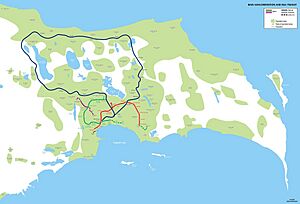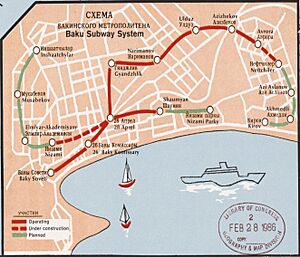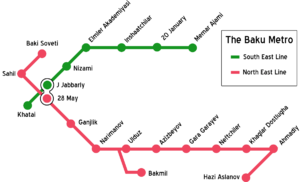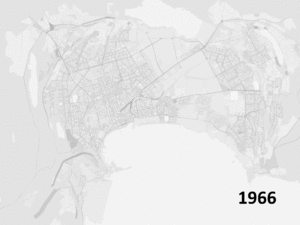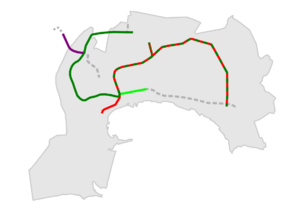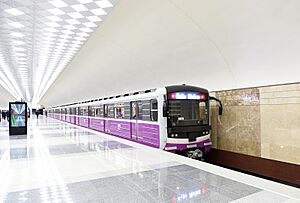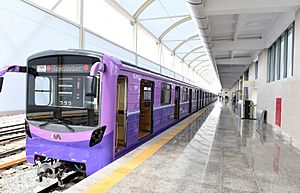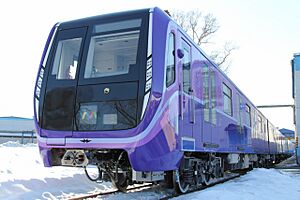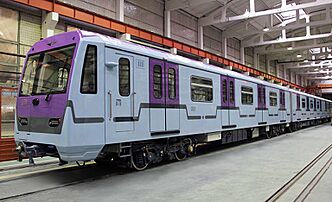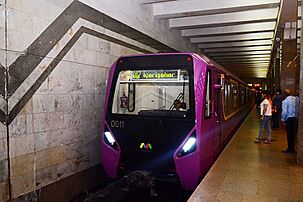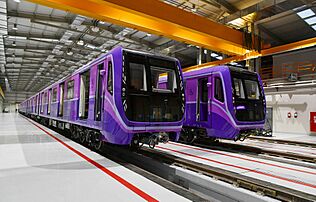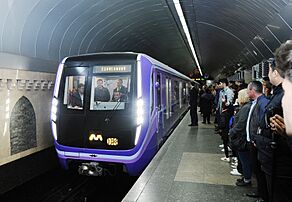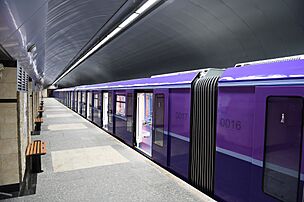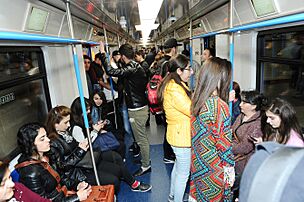Baku Metro facts for kids
Quick facts for kids Baku Metro |
|||
|---|---|---|---|
Icheri Sheher, Baku (P1090266).jpg |
|||
| Info | |||
| Owner | Baku Metro CJSC (Parent Company AZCON Holding) | ||
| Locale | Baku, Azerbaijan | ||
| Transit type | Rapid transit | ||
| Number of lines | 3 | ||
| Number of stations | 27 | ||
| Daily ridership | 627,279 (daily average, 2024) | ||
| Chief executive | Vusal Aslanov | ||
| Website | Baku Metro | ||
| Operation | |||
| Began operation | November 6, 1967 | ||
| Operator(s) | Add→ Bakı Metropoliteni | ||
| Number of vehicles | 228 | ||
| Technical | |||
| System length | 40.7 km (25.3 mi) | ||
| Track gauge | 1,520 mm (4 ft 11 27⁄32 in) Russian gauge | ||
| Electrification | Third rail, 825V DC | ||
|
|||
The Baku Metro (called Bakı metropoliteni in Azerbaijani) is a fast train system in Baku, the capital city of Azerbaijan. It helps people travel quickly around the city.
This metro system first opened on November 6, 1967. At that time, Azerbaijan was part of the Soviet Union. Because of this, the Baku Metro looks a lot like other metro systems built in the Soviet era. It has very deep stations and beautiful decorations. These decorations mix traditional Azerbaijani designs with Soviet ideas.
Today, the Baku Metro has three lines and 27 stations. Its tracks stretch for about 40.7 kilometers (25.3 miles). It is the only metro system in Azerbaijan. The Baku Metro was the fifth metro system built in the Soviet Union. It was also the 34th metro system in the world. In 2024, about 229.6 million passengers used the metro. This means about 627,279 people rode it every day!
The company that runs the Baku Metro is called Baku Metro Closed Joint-Stock Company (Baku Metro CJSC). It was created in 2014 by the President of Azerbaijan.
Contents
History of the Baku Metro
Baku became a very large city because oil was found in the Caspian Sea. This happened during the last years of the Russian Empire. By the 1930s, Baku was the capital of the Azerbaijani Soviet Socialist Republic. It was also the biggest city in the Soviet Transcaucasia region.
Plans for a fast train system started in the 1930s. After World War II, Baku's population grew to over one million people. This was a rule in the Soviet Union for building a metro system. So, in 1947, the Soviet government decided to build it. Construction began in 1951.
On November 6, 1967, the first part of the Baku Metro opened. It had 6.5 kilometers (4 miles) of track. This made it the fifth rapid-transit system in the Soviet Union. It opened to celebrate the 50th anniversary of the October Revolution.
Baku's landscape is hilly, so its metro lines were a bit different from other Soviet metros. Instead of a triangle shape, it had two lines that crossed in the city center. One line started in the southwest and went northeast. It then curved to the southeast and south. This line opened in stages, with the last part finished in 2002. A small branch line also opened in 1970.
The second line was planned to run along the Caspian coast. It would connect industrial areas and then turn west and north. To speed things up, a branch opened in 1968. Another part opened in 1976. For a while, both lines used the same station, May 28. This was fine at first, but as the second line grew, a new transfer station was needed.
In 1993, the first part of the Jafar Jabbarli transfer station opened. However, the end of the Soviet Union and other problems stopped construction. In the mid-1990s, there were also some very sad events. In 1994, terrorist attacks killed 27 people and injured 91. In 1995, a fire on a crowded train killed 289 people and injured 265. This was the world's deadliest subway disaster.
Construction slowly started again in the late 1990s. The Hazi Aslanov station was completed with help from the European Union. In the mid-2000s, work on the northern part of the second line began again. Nasimi station opened in 2008.
Baku Metro Network
Metro Lines
The Baku Metro has three main lines:
| Line | Segment | Date opened | Length | Stations |
|---|---|---|---|---|
| Red | Icheri Sheher ↔ Hazi Aslanov | 1967 | 20.1 km | 13 |
| Green | Darnagul ↔ Hazi Aslanov | 1976 | 12.2 km | 8 |
| Green | Shah Ismail Khatai ↔ Jafar Jabbarly | 1968 | 2.3 km | 2 |
| Purple | Khojasan ↔ 8 Noyabr | 2016 | 6.1 km | 4 |
Station Name Changes
Over time, some metro stations have been renamed:
| Old Name | New Name | Date of Change |
|---|---|---|
| Şaumyan | Xətai | May 11, 1990 |
| 26 Bakı Komissarı | Sahil | April 9, 1992 |
| XI Qızıl Ordu Meydanı | 20 Yanvar | April 27, 1992 |
| 28 Aprel | 28 May | April 9, 1992 |
| Avrora | Qara Qarayev | April 27, 1992 |
| Elektrozavod | Bakmil | January 1, 1993 |
| Bakı Soveti | İçәrişәhәr | April 25, 2007 |
| Məşədi Əzizbəyov | Koroğlu | December 30, 2011 |
Future Plans for the Metro
The Baku Metro has plans to grow even more. There are several new projects, and some are already being built. In 2011, the head of the Baku Metro said they planned to build up to 53 new stations by 2030.
For the Purple Line, the signal and communication systems are being updated by a company called Thales.
The Baku Metro will also be updated with modern technology. New stations will be able to handle longer trains with up to seven cars. These stations will have modern platforms, entrances, and escalators. They will also have new systems for signals and train control.
The most recent plan for the metro includes 5 lines, 77 stations, and about 119 kilometers (74 miles) of total track length.
How the Metro Works
The Baku Metro officially has two lines, but it works more like a system with four branches. Trains travel from Həzi Aslanov to either İçərişəhər or Dərnəgul. They split at May 28 station, which is under the main train station. Some trains also go to Bakmil, but only a few times an hour.
There is also a short "second line" that runs between Cəfər Cabbarlı and Şah İsmail Xətai. This is a shuttle service that uses only one track because not many people use it. Another transfer station is “Memar Əcəmi", where the Green and Purple Lines meet.
Because Baku has a hilly landscape, some stations are very deep underground. These deep stations could even be used as bomb shelters. This is because the system was built during the Cold War in the 1950s and early 1960s. Most of the stations, 13 of them, are shallow with pillars. One station, Bakmil, is at ground level with a single platform.
Like many other old Soviet metro systems, most Baku Metro stations are beautifully decorated. Many have art that shows Soviet ideas of progress and culture. Others show traditional Azerbaijani culture and history. After the Soviet Union ended, some stations were renamed. Some of their decorations were also changed to fit the new ideas.
Tickets and Fares
A single trip on the Baku Metro costs 50 gapiks (0.50 AZN). This price changed on July 1, 2024. Before 2006, people used metal or plastic tokens to enter the stations. In 2006, the metro started using RFID cards. These are rechargeable cards that you can put money on. You need to pay a small deposit for the card itself.
The BakuCard is a special smart card that you can use to pay for both the Baku Metro and BakuBus (city buses).
Wi-Fi and Phone Service
Work is happening to add free Wi-Fi service at Koroğlu station. Also, a local mobile company, Nar Mobile, has started providing 3G phone service at several stations. They plan to expand this service to all stations and even inside the tunnels soon.
Metro Trains
As of early 2020, the Baku Metro uses several types of trains. These include the 81-717/714 models and their updated versions. They also use newer 81-760B/761B/763B "Oka" and 81-765.B/766.B trains. All the trains on the Baku Metro have been made by Metrowagonmash with Alstom.
Since 2014, older 81-717/714 trains have been updated in Tbilisi, Georgia. They get new front parts and updated electrical systems. Inside, they have new controls and seats. Baku Metro has also updated some Soviet-era trains to make them more modern. New-generation metro trains (81-765 B/766B series) were also put together in Baku by Baku Metro LLC in October 2024.
In 2013, Baku Metro tried out an 81-760/761 "Oka" type train. After some tests, they decided to buy three five-car "Oka" trains. These trains had special features like gangways that let passengers walk between cars. These updated "Oka" trains started service on the Red line in April 2015.
In February 2018, Baku Metro ordered two new 81-765 "Moscow" type trains. The first one arrived in March 2018 and started running in April 2018. These trains are called 81-765.B/766.B. They are purple, like the "Oka" trains, but without gray. As of December 2024, there are 27 of these modern trains in the Baku Metro.
Metro Depots
Metro depots are places where trains are stored and repaired.
- Bakmil Depot - for the Red Line
- Khojasan Depot - for the Purple Line
- Darnagul Depot - for the Green Line (being built)
- Kohne Guneshli Depot - for the Green Line (planned)
- Ramana Depot - for the Blue Line (planned)
- Binagadi Depot - for the Yellow Line (planned)
Important Events
1994 Bombings
On March 19 and July 3, 1994, bombs exploded in the metro. These attacks caused 27 deaths and injured 91 people.
1995 Fire
On October 28, 1995, a fire happened on a train between the Ulduz and Nariman Narimanov stations. This terrible event killed 289 people and injured 265 others. The fire was thought to be caused by an electrical problem. This fire is known as the world's deadliest subway disaster.
See also
 In Spanish: Metro de Bakú para niños
In Spanish: Metro de Bakú para niños
- List of Baku metro stations
- Baku suburban railway
- Trams in Baku
- Baku Transport Agency
- Transport in Azerbaijan
- List of metro systems


